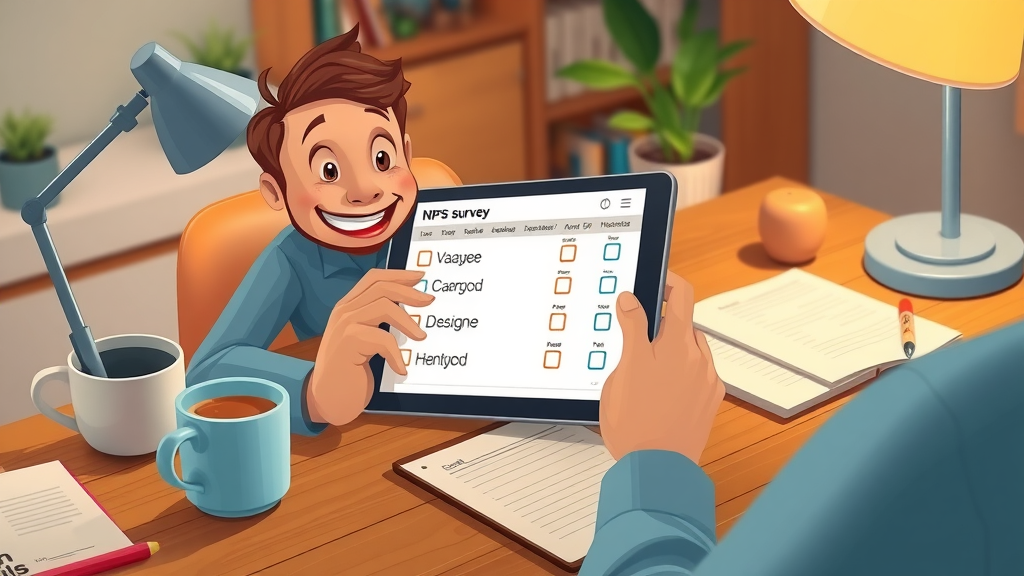Did you know that over 70% of product changes in top tech companies are made directly based on user feedback ? While businesses often guess at what users want, the reality is that feedback helps pinpoint the real pain points—and provides an actionable path toward improvement. In today's digital world, understanding and leveraging user feedback can be the difference between customer delight and irrelevance. Read on to learn how to uncover powerful insights instantly and enhance your user experience.

Revealing the Transformative Impact of User Feedback: The Key to Success
- What user feedback is and why it matters
- Methods to collect user feedback efficiently
- How leading product teams leverage feedback
- Strategies for structuring feedback surveys and usability tests
- Real examples and templates for effective feature requests and customer support responses
User feedback is the cornerstone of building successful products in any industry. Businesses that fail to listen often find themselves outpaced by competitors who consistently tune their offerings to what users really need. Transformative insights come not from isolated ideas but from actively listening to users’ voices: their satisfaction, frustration, pain points, and feature requests. Implementing a robust feedback loop—where feedback is continuously gathered, analyzed, and acted upon—empowers organizations to make precise product changes that drive growth and loyalty. The brands with the happiest customers are those that harness feedback to steer every aspect of their user experience, from first click to ongoing support. In this article, you’ll discover how to structure this process for maximum success.
Understanding User Feedback: Definitions and Core Concepts
What is user feedback?
User feedback refers to the opinions, suggestions, criticisms, or praise provided by the people who interact with your product or service. It forms the heartbeat of user research and signals how well your offering meets user expectations. Whether it’s a quick survey response in a mobile app , support tickets from your help desk, or in-depth usability testing sessions, every piece of feedback helps businesses understand user behavior and identify both strengths and weaknesses. Collecting feedback isn't just a formality—it's a crucial strategy for building user-centered solutions and driving innovation.

Why is user feedback essential for improving user experience?
Feedback helps designers and teams center their product development around actual user needs, rather than assumptions or internal preferences. By consistently collecting user feedback, businesses can spot pain points that may not be visible through analytics alone. For instance, indirect data might show that users drop off at a particular step, but only direct feedback reveals why that step is difficult. Proactive listening also boosts customer loyalty, as users feel heard and valued—turning casual customers into passionate advocates. In sum, user feedback is a vital fuel for iterative improvement, customer satisfaction, and enduring product success.
| Types of User Feedback | Examples | Best Use Cases |
|---|---|---|
| Direct Feedback | Surveys, Reviews | Product improvement, Customer support |
| Indirect Feedback | Usage Metrics, Analytics | Feature prioritization, Usability enhancements |
| Passive Feedback | NPS, Social mentions | Brand perception, Loyalty measurement |
Collecting User Feedback: Strategies and Tools

Methods to collect user feedback efficiently
To collect user feedback effectively, a blend of qualitative and quantitative approaches provides the richest insight. Start with feedback surveys —delivered via email, embedded in your website, or as pop-ups in mobile apps . Next, conduct usability tests, which allow you to observe real users as they interact with your product, exposing usability issues and generating practical suggestions. In-app prompts and feedback widgets can solicit instant reactions after a user completes a key task. Don’t forget to tap into customer support interactions and support tickets, which reveal recurring pain points. Finally, social media listening tools track indirect user feedback from organic brand mentions on platforms like Twitter and Reddit, offering an unfiltered look at customer sentiment.
- Feedback surveys
- Usability tests
- In-app prompts in mobile apps and web services
- Customer support tickets
- Social media listening
How to choose the right feedback collection method
Not all user research tools are equal—and the best choice depends on your goals. If you want to track overall satisfaction, Net Promoter Score (NPS) surveys are quick and easy. To detect usability friction, organize hands-on usability testing . When prioritizing the next big feature request , open-ended surveys and customer interviews provide context behind the data. Analytics and feedback widgets are excellent for gathering indirect and passive signals as users interact naturally with your product. By diversifying your approach, you create a feedback-rich environment that empowers the product team to prioritize based on real, diverse, and actionable user input.
“The most valuable insights don’t always come from the loudest customers, but the most observant ones.” – Product Team Leader
Best Practices for Structuring User Feedback Surveys
Designing effective feedback survey questions
A well-crafted feedback survey begins with clear, concise questions that get to the heart of user experience without causing confusion or survey fatigue. Start by asking about specific scenarios, not just generic satisfaction—such as, “How easy was it to complete your last purchase?” Mix quantitative questions (like NPS on a scale of 0–10) with open-ended prompts to capture rich qualitative insights. For usability, focus on pain points (“What was the most difficult part of this process?”) and invite suggestions for improvement. Importantly, keep the survey short; users are more likely to respond if it’s quick and relevant.
- Keep questions clear and concise
- Focus on user experience and usability
- Include open-ended and quantitative questions
- Use Net Promoter Score (NPS) for quick loyalty insights
Sample feedback survey templates and implementation
Implementing effective surveys involves more than just good questions—it’s about timing, medium, and follow-up. For example, an in-app survey triggered after a user completes onboarding will yield immediate, relevant feedback. Email surveys post-purchase can capture broader sentiment, while exit surveys help explain why users leave. Companies like Google and Amazon routinely refine their products based on survey results, integrating both standardized metrics (NPS, CSAT) and custom questions tailored to their roadmap. Ensure your survey platform (such as Typeform, SurveyMonkey, or Google Forms) supports analytics and reporting, so you can translate raw feedback into actionable next steps for your product team .

Leveraging User Feedback for Product Improvement
How product teams use collected user feedback
Product teams treat user feedback as a living resource—returning to it constantly for fresh direction. Collected feedback fuels weekly reviews, with teams analyzing suggestions, complaint patterns, new feature requests , and customer satisfaction metrics. Using dashboards that aggregate survey, ticket, and analytics data, they can visually map user pain points and identify high-impact issues. By tagging and prioritizing feedback, teams make smarter roadmap decisions, invest in the right features, and iterate faster—improving retention and conversion rates across the board.

Incorporating feedback to guide feature requests and updates
Modern teams don’t just collect feedback—they act on it. By launching public boards (such as Trello or UserVoice), teams make feature requests and progress transparent, inviting more community participation and upvotes. Tagging feedback allows for trend analysis, revealing which pain points or ideas are most urgent across different user segments. After a release, sharing update notes or personal thank-you messages closes the loop, building trust and loyalty. Ultimately, the cycle of collecting, analyzing, and acting on user feedback becomes the engine of continuous product improvement.
- Use tagged feedback for trend analysis
- Create feedback boards to publicly track requests
- Share updates with users post-release to build loyalty
“Collecting user feedback isn’t just a process—it’s a mindset that keeps innovation alive.” – UX Research Director
Real-Life Case Studies: User Feedback in Action
How mobile apps improved user experience using customer feedback
Many leading mobile apps — from banking to social media — have made radical improvements by systematically gathering and acting on customer feedback . For example, an app’s in-app survey revealed users were frustrated by a confusing payment flow. By observing users during a usability test and analyzing written feedback, the product team identified and streamlined the problematic steps. As a result, not only did feature adoption rise, but app store reviews and NPS scores improved dramatically. These data-driven enhancements show how real user voices can lead directly to a stronger, more competitive product or service.

Customer support’s role in listening to user feedback
Customer support isn’t just about solving problems; it offers a front row seat to user sentiment. Every ticket or call is an opportunity to spot recurring pain points that analytics may miss. For instance, a surge in inquiries after a new feature launch might indicate confusing design or documentation gaps. By categorizing and relaying these trends to the product team , support can directly influence feature requests and usability enhancements, driving a customer-centric culture from the ground up.
Actionable Steps: Building an Effective User Feedback Loop
Steps for collecting and implementing user feedback
Creating a seamless user feedback loop aligns teams, streamlines product development, and maximizes improvements. Follow these proven steps to make feedback work for you:
- Identify feedback channels (e.g., app surveys, support tickets)
- Collect and categorize data
- Regularly review with the product team
- Communicate changes to your user base
- Measure improvements via net promoter scores and other KPIs

Overcoming challenges in collecting user feedback
Despite best intentions, collecting user feedback poses challenges. Users may hesitate to provide honest responses or ignore repetitive surveys. Combat this by ensuring anonymity, asking for feedback at natural touchpoints, and communicating how their input makes a difference. Avoid survey fatigue by keeping requests brief and relevant. When negative comments arise, respond promptly with empathy and clear follow-up actions—transforming detractors into loyal fans through visible improvements. By viewing complaints as opportunities, organizations can continually iterate and deliver a best-in-class user experience .
- Encourage honest, constructive feedback
- Avoid survey fatigue
- Address negative comments with actionable follow-ups
Frequently Asked Questions About User Feedback
What is user feedback?

User feedback consists of input, comments, and ratings provided by users regarding their experience with a product or service. It can range from detailed survey responses to quick ratings or feature requests. Collecting such data helps businesses understand how well their offerings meet customer needs and identify opportunities for improvement.
How important is user feedback?
User feedback is deeply important because it guides improvements in user experience, helps resolve pain points, and informs product development. Companies that prioritize user feedback innovate more quickly, increase satisfaction, and build customer loyalty. Ignoring feedback, on the other hand, leads to missed opportunities and higher churn rates.
How to write user feedback?
To write quality user feedback, be specific about your experience. Mention the part of the product or service you used, describe what worked or what didn’t, and suggest possible improvements if applicable. Clear feedback—positive or negative—helps companies take meaningful action, making the experience better for everyone.
What is a good feedback message example?
A good example would be: “I love how easy it is to upload photos, but I had trouble editing captions. A simpler caption editor would improve my experience.” This message is actionable, polite, and points to both strengths and areas for growth, ensuring the product team can address the issue directly.
Lists: Tried-and-True Tools for Collecting and Analyzing User Feedback
- Feedback survey platforms: SurveyMonkey, Typeform, Google Forms
- Net Promoter Score (NPS) Tools: Delighted, Satismeter
- Customer Support: Zendesk, Intercom
- Usability Test Suites: UserTesting, Lookback.io
Tables: User Feedback Metrics That Matter
| Metric | Description | Why It Matters |
|---|---|---|
| NPS (Net Promoter Score) | Measures loyalty on a 0–10 scale | Reveals satisfaction, growth potential |
| CSAT (Customer Satisfaction) | Rates satisfaction at a point in time | Tracks post-support or major update reaction |
| CES (Customer Effort Score) | Assesses ease of product use | Informs usability improvements |
Quotes from Industry Leaders on Leveraging User Feedback
“If you don’t actively seek out user feedback, you’re only guessing.” – Chief Product Officer
“Listening to our users shapes every product decision we make.” – Mobile App Growth Lead
People Also Ask: Deepening Your Understanding of User Feedback
What is user feedback?

User feedback is any information users provide about their experience—from ratings and complaints to suggestions and praise. Collecting and acting on this feedback helps organizations deliver better user experiences and shape future updates.
How important is user feedback?
User feedback is essential for keeping your product or service aligned with market needs. Consistently gathering and analyzing it informs everything from usability to loyalty, providing a direct line to your customers’ evolving expectations.
How to write user feedback?
Write feedback by focusing on clarity and actionable details. State what you liked or didn’t like, explain why, and offer suggestions. Companies value specific feedback because it drives meaningful improvements and positive change.
What is a good feedback message example?
“The onboarding process was smooth, but adding tooltips for new users would help reduce confusion.” This direct, constructive message helps the product team target precise improvements.
Action Plan: Harness User Feedback for Transformational Change

Ready to unlock transformational change? Encourage feedback at every touchpoint, integrate findings into your roadmap, and communicate progress to your users. With a strong feedback loop, your organization can drive innovation, foster loyalty, and deliver industry-leading experiences.
Conclusion
Start collecting user feedback today—act on it, communicate your improvements, and transform your customer experience with data-driven decisions.
Sources
- UserTesting – https://www.usertesting.com/blog/user-feedback-examples
- SurveyMonkey – https://www.surveymonkey.com/curiosity/how-to-get-customer-feedback/
- Appcues – https://www.appcues.com/blog/collect-user-feedback
- Intercom – https://www.intercom.com/blog/how-to-collect-customer-feedback/
To deepen your understanding of user feedback and its pivotal role in product development, consider exploring the following resources:
- “A Founder’s Guide to Collecting and Utilizing User Feedback” ( helpscout.com )
This guide offers actionable questions and strategies to effectively gather and implement user feedback, helping you align your product with customer needs.
- “How to Collect End-User Feedback (Best Practices)” ( whatfix.com )
This article outlines best practices for collecting end-user feedback, including segmenting users, building feedback loops, and balancing quantitative and qualitative data.
By delving into these resources, you’ll gain valuable insights into creating a robust feedback loop that drives product improvement and enhances user satisfaction.
 Add Row
Add Row  Add
Add 




Write A Comment